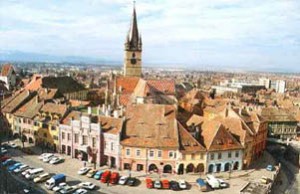Sibiu – home of Geo Strategies, Romania’s first Joint Venture company with the United Kingdom specialising in mapping, GIS and marketing services.
Roots of family and friends
Sibiu is the cultural centre of Transylvania. Called Hermannstadt by the Saxon colonists, Sibiu became a prosperous commercial centre in the XIV century. Documents dating from 1376 list 19 guilds practising 25 crafts. The town also had strong commercial relations with the South and East and, because of the economic strength of the guilds, Sibiu played a key role in Transylvania.
The original town, built in the fifteenth century, was protected by walls and brick towers. The buildings were joined by tunnels and narrow passageways, with heavily grated windows to cover the stairways and corners where intruders might attack. Everywhere you look, there is evidence of Sibiu’s historical past. In fact, the whole town breathes ‘history’.
The buildings are painted red, orange, sky blue, apricot and pea green and the roof-scape is truly magnificent. There are numerous cafes and restaurants, as well as interesting churches and museums. Surrounding Sibiu are a number of stunning villages with fortified churches and rows of houses typified by a highly coloured, but solid wall to the street.
‘Marginimea Sibiului’ – the villages around Sibiu – are hidden in the mountains and the valleys. These communities are very rich in architecture, history and heritage and have resisted the ravages of time. Towards Fagaras, Tarnave and Sebes there are many wealthy Romanian and Saxon villages defended by fortified churches and with hardworking people.
In 2007, the Council of Europe designated Sibiu as the ‘Cultural Capital of Europe’ in recognition of its unique position in the history of Transylvania. The local administration seized this opportunity to renovate much of the city centre which has now become a significant tourist destination.
Not least, of course, Sibiu is the home of Geo Strategies in Romania.
